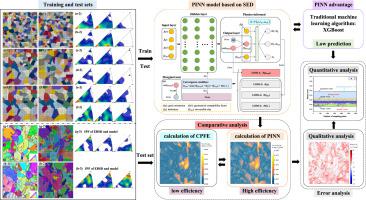当前位置:
X-MOL 学术
›
Int. J. Plasticity
›
论文详情
Our official English website, www.x-mol.net, welcomes your
feedback! (Note: you will need to create a separate account there.)
Stored energy density solution for TSV-Cu structure deformation under thermal cyclic loading based on PINN
International Journal of Plasticity ( IF 9.4 ) Pub Date : 2024-06-22 , DOI: 10.1016/j.ijplas.2024.104046 Hongjiang Qian , Jiebin Shen , Zhiyong Huang , Jian Wang , Qingyun Zhu , Zeshuai Shen , Haidong FAN
International Journal of Plasticity ( IF 9.4 ) Pub Date : 2024-06-22 , DOI: 10.1016/j.ijplas.2024.104046 Hongjiang Qian , Jiebin Shen , Zhiyong Huang , Jian Wang , Qingyun Zhu , Zeshuai Shen , Haidong FAN

|
TSV-Cu is widely used for chip interconnects, where high testing costs and complex crystal plasticity finite element (CPFE) limit the research of its deep microplastic evolution process. Considering the stored energy density (SED) based on dislocation density and plastic work as a fatigue indicator factor (FIP), this paper proposes for the first time a physics-informed neural network (PINN) framework based on SED, which aims to achieve the solution of SED distributions quickly and efficiently to save computational time and cost. The grain orientation, geometrical compatibility factor, back stress, and effective plastic strain are taken into account as inputs to the PINN model. The total dislocation density is used as an indirect solution variable to construct the associated loss boundary terms, which results in the solution of the SED. The results of the two real EBSD tests show that the PINN model is able to accurately and sensitively predict the SED concentration distribution for different thermal cycle loadings, and maintains a high degree of agreement with the CPFE calculation results. Moreover, The superiority of PINN over other machine learning algorithms in terms of physical model interpretation and prediction accuracy is verified. These make it a reality for PINN to solve for the FIP distribution for the first time, and to accurately and quickly predict the location of crack initiation.
中文翻译:

基于PINN的热循环加载下TSV-Cu结构变形储能密度求解
TSV-Cu广泛用于芯片互连,其高测试成本和复杂的晶体塑性有限元(CPFE)限制了其深层微塑性演化过程的研究。考虑到基于位错密度的存储能量密度(SED)和塑性功作为疲劳指标因子(FIP),本文首次提出了基于SED的物理信息神经网络(PINN)框架,旨在实现快速有效地解决 SED 分布,以节省计算时间和成本。晶粒取向、几何相容系数、背应力和有效塑性应变均被考虑作为 PINN 模型的输入。总位错密度用作间接解变量来构造相关的损失边界项,从而得出 SED 的解。两次真实EBSD测试结果表明,PINN模型能够准确、灵敏地预测不同热循环载荷下的SED浓度分布,并与CPFE计算结果保持高度一致。而且,PINN在物理模型解释和预测精度方面相对于其他机器学习算法的优越性得到了验证。这些使得PINN首次求解FIP分布并准确快速地预测裂纹萌生位置成为现实。
更新日期:2024-06-22
中文翻译:

基于PINN的热循环加载下TSV-Cu结构变形储能密度求解
TSV-Cu广泛用于芯片互连,其高测试成本和复杂的晶体塑性有限元(CPFE)限制了其深层微塑性演化过程的研究。考虑到基于位错密度的存储能量密度(SED)和塑性功作为疲劳指标因子(FIP),本文首次提出了基于SED的物理信息神经网络(PINN)框架,旨在实现快速有效地解决 SED 分布,以节省计算时间和成本。晶粒取向、几何相容系数、背应力和有效塑性应变均被考虑作为 PINN 模型的输入。总位错密度用作间接解变量来构造相关的损失边界项,从而得出 SED 的解。两次真实EBSD测试结果表明,PINN模型能够准确、灵敏地预测不同热循环载荷下的SED浓度分布,并与CPFE计算结果保持高度一致。而且,PINN在物理模型解释和预测精度方面相对于其他机器学习算法的优越性得到了验证。这些使得PINN首次求解FIP分布并准确快速地预测裂纹萌生位置成为现实。











































 京公网安备 11010802027423号
京公网安备 11010802027423号